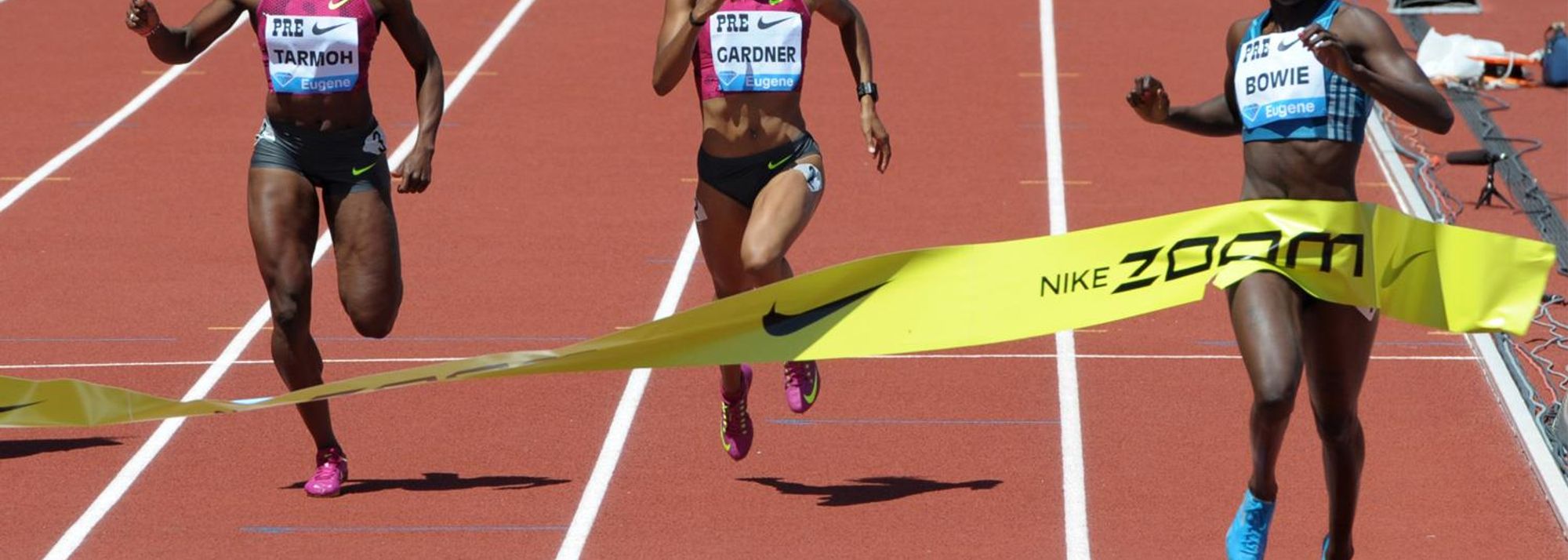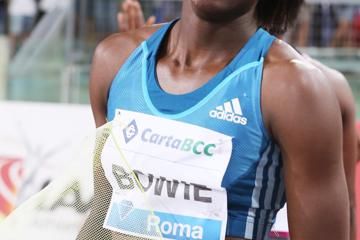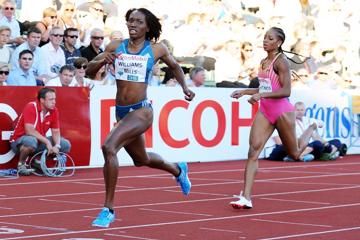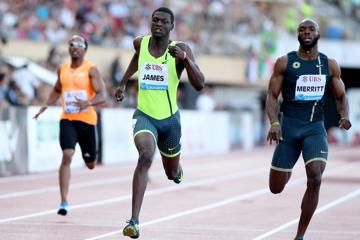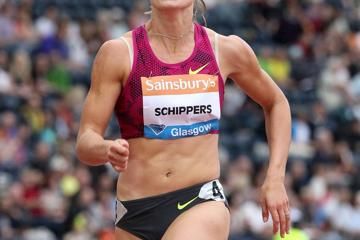Tori Bowie wins the 200m at the IAAF Diamond League meeting in Eugene (© Kirby Lee)
Statisticians Mirko Jalava and A Lennart Julin look back at the best long-distance running performances of the year.
Men’s 100m
Justin Gatlin made an explosive return to the top of the 100m during the 2014 season. The 32-year-old US sprinter won all 16 starts (one heat), meaning he will be taking a streak of 15 wins to the 2015 campaign.
Gatlin’s year included five world leaders and five wins in IAAF Diamond League meetings with the best result, a 9.77 personal best, coming in Brussels in September.
Fellow US sprinter Mike Rodgers was a clear world No.2 in 2014. The 29-year-old recorded seven sub-10-second races (two wind aided) and won at the IAAF Diamond League meetings in Paris and London. He also won the US Championships and was the fourth-fastest athlete of the season, clocking 9.91 in London in July.
Jamaican Kemar Bailey-Cole might have only been the equal ninth-fastest athlete on the 2014 world list, but he did win some important races. A 10.00 victory at the Commonwealth Games in Glasgow was followed by an IAAF Diamond League win in 10.08 in Birmingham and a 9.96 season’s best to win at the IAAF Diamond League meeting in Zurich.
Asafa Powell ran 9.87 at a small meeting in Austin in August following a few slower races in July. The 32-year-old went on to clock two more sub-10-second times in Brussels and Rieti in September.
James Dasaolu was the top European, winning the European Championships in Zurich in 10.04, while former Nigerian Femi Ogunode lowered the Asian record to 9.93 when winning the Asian Games in Inchon.
Men’s 200m
Justin Gatlin was the No.1 in this event as well, despite the fact that he only raced three times at this distance during the season. The last two of those races were the two fastest and both IAAF Diamond League wins: first a 19.68 personal best in Monaco in July, followed by a 19.71 clocking in Brussels in September.
Alonso Edward made a successful return to the 200m elite after a five-year break. The Panamanian surprised everyone at the 2009 World Championships to take the 200m silver medal with a 19.81 South American record and world age-19 best. It took him five years to produce another sub-20-second race, but it was clear from the start of the season that he was back to top form.
A total of 11 races with eight wins, four of them at IAAF Diamond League meetings, was an impressive return. Edward came close to his record in Lausanne in July, winning in 19.84, and went on to win the Continental Cup in Marrakech in September, clocking 19.98 for his third career sub-20-second performance.
Jamaican Nickel Ashmeade raced only six times, but with strong results. The 24-year-old won two and placed second four times, including two performances faster than 20.00, clocking 19.95 in New York and 19.99 in Monaco.
Fellow Jamaican Warren Weir started fast, winning in New York in a then world-leading 19.82, but couldn’t get close that mark later in the season. The world silver medallist finished second in Glasgow in July at the Commonwealth Games before injury forced him out of the rest of the season.
Adam Gemili was the top European with the 21-year-old Briton equalling his 19.98 personal best for the title in Zurich at the European Championships in August.
Men’s 400m
LaShawn Merritt won the first race of the season against Kirani James at the Drake Relays, 44.44 to 44.60, but the Grenadian was on top for the rest of the season.
The 22-year-old clocked two sub-44-second races with world-leading wins in Eugene (43.97) and Lausanne (43.74), the latter race lowering his national record by 0.2. James went on to win the Commonwealth Games in Glasgow in July and the Birmingham IAAF Diamond League meeting in August.
USA’s 28-year-old Merritt raced more frequently with 15 finals during 2014. 12 wins out of those 15, including five in IAAF Diamond League meetings as well as the Continental Cup in Marrakech and a 43.92 season’s best, made sure the world champion remained in the picture.
Area records were broken for both Africa and Asia. Isaac Makwala of Botswana ran a 44.01 African record in La Chaux-de-Fonds in July, breaking Gary Kikaya’s previous record of 44.10 from 2006. A much older record fell for Asia, with Oman’s Mohamed Al-Malky’s 44.56 almost completing 26 years in the history books, before Youssef Al-Masrahi’s third-place finish in 44.43 in Lausanne in July.
The 26-year-old Saudi Arabian had a good season, recording two more races under the previous record with 44.55 in Montreuil in July and 44.46 when winning the Asian Games in Inchon in September.
Women’s 100m
In 2013 this event was owned by world champion Shelly-Ann Fraser-Pryce, so when the Jamaican opened this season by winning the world indoor 60m title and a victory at the IAAF Diamond League meeting in Doha, it looked as though 2014 would be a rerun of last year.
But due to injury niggles, Fraser-Pryce’s season dwindled and instead the No. 1 position seemed to change hands almost by the week through the summer. In early June, Tori Bowie – previously regarded as a long jumper – upset the sprint establishment with impressive wins in Rome and New York, only to disappear just as quickly due to injury.
Filling the vacancy that emerged was Trinidad’s Michelle-Lee Ahye, who won in Lausanne and Glasgow before pulling her hamstring. In Monaco, Bowie made a masterful comeback winning by almost two metres in a world-leading 10.80. But her injury woes returned.
So during the last part of the season, super-experienced Veronica Campbell-Brown had most success. After finishing second to Bowie in Monaco and to Nigeria’s Blessing Okagbare in the Commonwealth Games, the Jamaican went on to win the IAAF Diamond League final in Zurich, hard pressed by Ivory Coast’s Murielle Ahoure, and the Continental Cup ahead of a resurgent Ahye.
So who was the best overall? There is no simple answer, but newcomer Bowie was definitely the most impressive when fit. If she can stay healthy next year, Bowie looks like the USA’s best chance to challenge consummate championship performer Fraser-Pryce for the world title in Beijing.
Women’s 200m
This event has been dominated by two athletes for the best part of the past decade. Veronica Campbell-Brown of Jamaica and Allyson Felix of the USA have between them took all the seven global gold medals – as well as four of the silvers – between 2004 and 2012.
But this year Campbell-Brown focused on the 100m and Felix, while competing, was gradually on a return-to-form path after her hamstring pull at the 2013 World Championships. With world champion Shelly-Ann Fraser-Pryce having an off-year due to injury, the event was open for new challengers.
Dutch heptathlete Dafne Schippers provided the most impressive performance of the year when, in unfavourable wet and windy weather, she powered to a 22.03 win at the European Championships in Zurich. She also beat a quality field, which included Felix, at the Glasgow IAAF Diamond League meeting and went on to end her season with victory at the Continental Cup.
But despite her sprinting success in 2014, Schippers reportedly maintains that the heptathlon remains her priority.
Other young challengers emerged in 2014. British teen prodigy Jodie Williams, now 21, finally lowered her four-year-old PB to 22.46 and collected silver at both the Commonwealth Games, behind Nigeria’s versatile Blessing Okagbare, and the European Championships.
But still the most exciting prospect – just like in the 100m – could be former long jumper Tori Bowie. Coming into this year with a 23.99 PB from 2009, Bowie shocked everyone at the Prefontaine Classic in Eugene in late May, running 22.18 from lane one to defeat all the specialists. Unfortunately recurring injuries prevented the 23-year-old from having a full season.
Women’s 400m
Jamaican veteran Novlene Williams-Mills had a perfect start to the season, winning the first three IAAF Diamond League events and the national title. But during the rest of the summer she was involved in a three-way battle for the top position with Francena McCorory and Sanya Richards-Ross of the USA.
Williams-Mills won in Stockholm, McCorory in New York and Glasgow and Richards-Ross in Paris and the IAAF Diamond League final in Brussels. World indoor champion McCorory – who ran a world-leading 49.48 at the US Championships – got the final word by narrowly defeating Williams-Mills at the Continental Cup.
Always there from May to September was the second Jamaican, Stephenie Ann McPherson who finished between second and fourth in all seven of her IAAF Diamond League races but whose only major win was the Commonwealth Games where she was one step ahead of Williams-Mills.
All four of these athletes were well established at the top level before 2014, so too was European champion Libania Grenot. But there was one youngster on the US collegiate scene that could have mixed it up with the major players.
With her PB of 50.03, 20-year-old Courtney Okolo was third on the world list, behind only McCorory and Richards-Ross, and won the NCAA title in 50.23.
Traditionally Russia has provided the main challenge to the US for the best depth in this event, but this year the leading Russian was just 30th on the world list. Four years ago, they had four in the top 10 and even as recently as last year they had two in the world’s top four, and five in the top 17.
Mirko Jalava (men’s events) and A Lennart Julin (women’s events) for the IAAF
